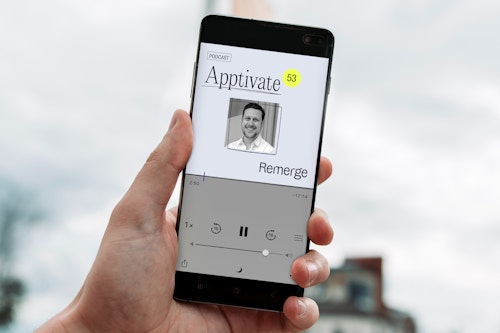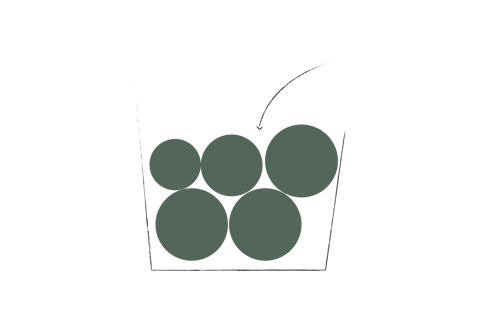Here's how retargeting supports app growth for gaming
June 26, 2022
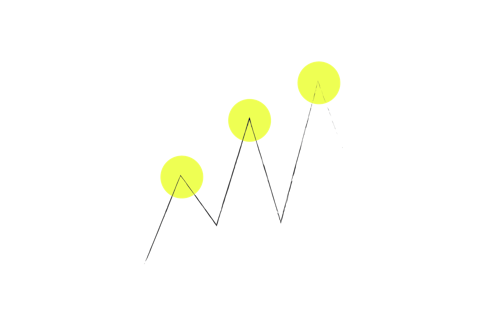
Competition continues to be one of the main challenges for mobile game developers, exacerbated by the sheer number of games that are out there. On one side, we see a growing user interest in games; on the other hand, with more and more new games entering the market, it’s becoming harder and harder for games to turn their new users into engaged and paying players.
In this article, we breakdown the main ways retargeting can support growth for gaming apps.
Why do gaming apps need retargeting?
How do mobile gaming apps turn a large user base into an audience that is truly engaged and drives revenue? One way is in-app retargeting.
The latest data report from Adjust highlights that gaming users are expensive to acquire, but session lengths and frequency are increasing, creating more opportunities to increase in-app revenue from loyal users. The total time spent in app per user over a 24 hour period grew in 2021. Day 1 total time in app rose from 50.3 minutes to 53.3 minutes, day 3 from 44.9 to 47.2, day 7 from 43.3 to 45.5, day 14 from 41.7 to 44.2, and day 30 from 41.1 to 43.0.
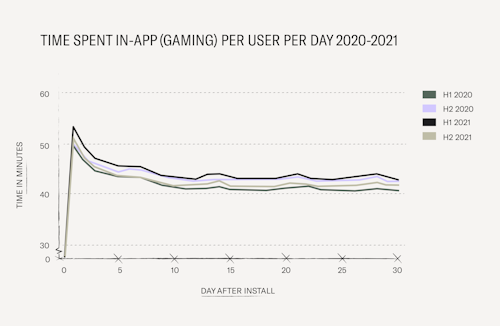
Source: Adjust's Mobile App Trends 2022
Retargeting campaigns keep these dedicated users engaged and playing regularly through personalized ad content and can incentivize paying players to keep spending more, and more often. For the gaming industry, retaining users is critical and, considering that it costs less to retarget a user than to acquire a new one, planning long-lasting retargeting campaigns is a sound investment.
In fact, according to Appsflyer data, the average revenue uplift among paying users who were exposed to a retargeting campaign was over 50% in gaming apps, more than double the industry average.
Where are the opportunities?
According to the same Appsflyer report, only 11% of gaming apps put their chips in retargeting. This is quite a low percentage in comparison to other verticals such as e-commerce, where 53% of apps already have retargeting strategies in place.
There is still a significant margin of gaming apps waiting to benefit from retargeting to stay relevant in the face of competition. Performance uplift is high for apps that put in the effort.
How does retargeting add value?
In short, a retargeting strategy will ensure gaming apps:
- Increase user retention
- Improve engagement levels
- Increase in-app conversions
A well planned retargeting strategy will ensure that a user base remains active and engaged throughout the game’s lifetime. Let’s dive into how retargeting can support a gaming app throughout the different stages of its lifetime.
Retargeting and the game lifecycle: launch, growth, peak, and endgame
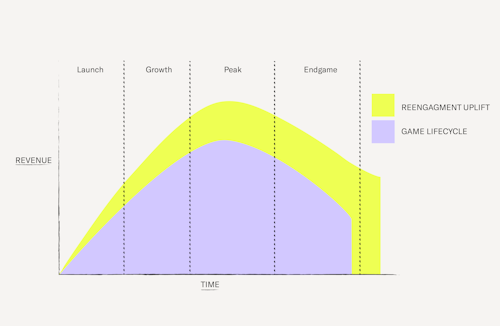
Stage 1 - Launch
When launching a new game, user acquisition must be accompanied by strong efforts to increase engagement and remind users to come back to a game after the install. The primary goals after acquiring new users are to provide a good onboarding experience, offer educational content, and convert them into paying users. Retargeting campaigns allow gaming apps to retain users by bringing them back to the app to complete a tutorial or start playing. These approaches will make the game more relevant to players and consequently maximize user lifetime value (LTV).
A report by Adjust mentions that, for gaming, the average time between a user’s last session and uninstall is three days; therefore, the window to retain and convert is small. Waiting for seven days of inactivity to initiate retargeting is missing a big opportunity. A large proportion of users (~40%) who uninstall an app won’t come back to re-download it. Running retargeting campaigns is instrumental in preventing churn after the install and providing valuable insights about your users early on. Retargeting partners will use in-app to optimize a campaign's segmentation strategy, thus maximizing ROI and boosting retention.
« App retargeting shouldn’t be a one-off tactic. It is an ongoing project that must be monitored and nurtured over time. »
Stages 2 and 3 - Game growth and peak
Retargeting campaigns add significant value during the growth and peak stages of a mobile game by re-engaging users who have yet to convert. They allow advertisers to target paying players to avoid drops in user activity and keep users engaged by showing ads that encourage them to play the entire game or make another purchase.
Retargeting also helps increase an app’s DAU (daily active users) by bringing back active users in high volumes at a low cost. It offers the chance to target users that exhibit a certain behavior or value. For instance, gaming apps that increase revenue by targeting a specific portion of their DAU can build a retargeting strategy that consistently re-engages these big spenders early in their lifetime.
At this growth stage, the focus is not only about scaling unique user numbers but, most importantly, to re-engage regular players and deepen their experience with the game before they lose interest. Retargeting assists in reaching these users whenever you want to inform them of any novelty and game areas they have not yet explored.
Identifying users that have completed certain levels or made their first in-app purchase makes it easier to target these specific segments with a different and more catered message. So, for example, users who have just completed a transaction would see an ad with a special offer for future purchases. At the same time, users who have completed a certain level will see an ad that references aspects of that level (e.g., setting, character, or prize to be redeemed) and incentivizes them to continue.
Stage 4 - Established games
For mature titles, retargeting can bring churned users back to the game. Once apps reach their peak in terms of reach and installs, it becomes increasingly challenging to reduce user churn, and the focus shifts from growth to maintenance and efficiency. Informing users efficiently, and at scale, about product updates is key to extending LTV.
At this lifecycle stage, marketers will have gathered a decent-sized chunk of data that will provide deeper insights into the entire user base and its behaviors.
Established games still have to put effort into their product in terms of improving the game and introducing new mechanics or levels, for example. Retargeting can then help reach users and encourage them to try new updates. It’s also crucial to identify “whales”, your most high-value user, and retarget them. These users make up a loyal user base and their interactions keep the game alive and profitable.
Recap
Retargeting remains one of the biggest missed opportunities for gaming apps as the industry is yet to fully adopt these strategies. Considering that retargeting is shown to be a more affordable strategy in the marketing arsenal than UA, there is an excellent opportunity for gaming apps that are ready to invest and implement retargeting strategies.
App retargeting shouldn’t be a one-off tactic. It is an ongoing project that must be monitored and nurtured over time. The most successful campaigns are those that are continually evolving as a response to insights from performance data. Measuring incremental growth and knowing the real value of retargeting is now a straightforward process with Remerge. Measuring uplift is done transparently based on accessible raw data to give marketers maximum insights and to optimize their investments further.
Get the latest app marketing insights
Join our newsletter

